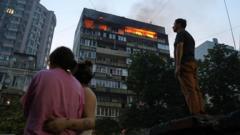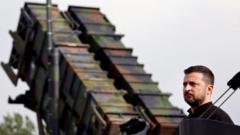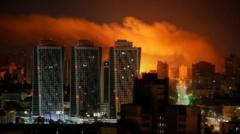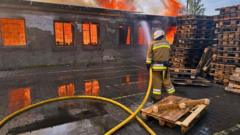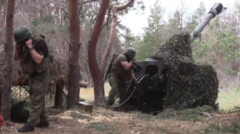A recent Greenpeace report highlights Russia's construction of electricity lines aimed at linking the Zaporizhzhia nuclear power plant to its power grid, signaling intentions to restart the facility amid ongoing conflict, despite significant safety risks.
New Evidence Emerges of Russia's Intent to Reactivate Zaporizhzhia Nuclear Plant

New Evidence Emerges of Russia's Intent to Reactivate Zaporizhzhia Nuclear Plant
Greenpeace's latest report unveils satellite images showing Russia's construction of power lines to connect the seized plant to its grid, raising nuclear safety concerns.
Russia is intensifying efforts to re-establish operational control over the Zaporizhzhia nuclear power plant in southeastern Ukraine, according to a report recently released by Greenpeace. The report reveals satellite images displaying the construction of new power lines designed to connect the facility, which has been under Russian control since the early days of the war, to Moscow's electrical grid. This development marks a troubling indication of Russia's ambitions to revive and exploit the nuclear plant, even as global concerns over safety persist.
The Zaporizhzhia nuclear plant has drawn international condemnation after being seized by Russian forces, given its precarious location amid active fighting. Experts fear that any attempt to restart the plant could lead to catastrophic consequences, with the Greenpeace report further complicating the situation by detailing the construction of over 50 miles of new electrical lines and pylons in occupied regions near Mariupol and Berdyansk.
These power lines, which have been verified through satellite imagery by The New York Times, aim to connect to a substation near Mariupol that serves as a conduit to the Zaporizhzhia facility, located approximately 140 miles away. Shaun Burnie, a nuclear specialist at Greenpeace Ukraine, emphasized that this development constitutes the first concrete evidence of Russia's plans to secure electricity for the plant, underscoring Putin's intentions in the region.
The future of the nuclear facility remains uncertain. Questions loom over whether Russia intends to operate the plant during the ongoing conflict or after a potential cessation of hostilities. Regardless of the timeline, experts advise that additional infrastructure will be needed to connect the plant to the Russian grid, with significant time required for completion. As the situation unfolds, the specter of a nuclear crisis lingers, drawing attention to the urgent need for reassessment of safety protocols in the region.





